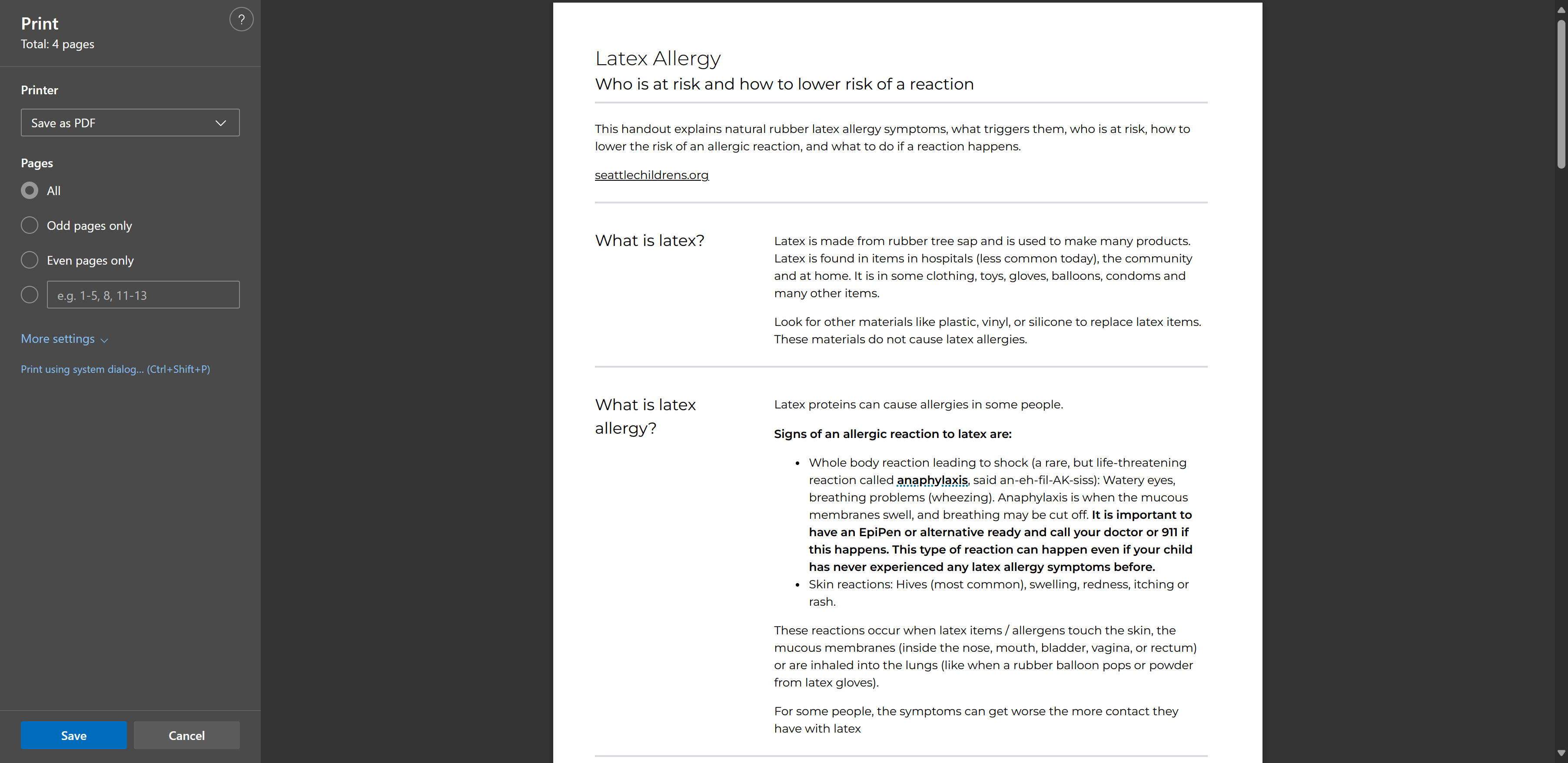Latex Allergy
Who is at risk and how to lower risk of a reaction
This handout explains natural rubber latex allergy symptoms, what triggers them, who is at risk, how to lower the risk of an allergic reaction, and what to do if a reaction happens.
What is latex?
Latex is made from rubber tree sap and is used to make many products. Latex is found in items in hospitals (less common today), the community and at home. It is in some clothing, toys, gloves, balloons, condoms and many other items.
Look for other materials like plastic, vinyl, or silicone to replace latex items. These materials do not cause latex allergies.
What is latex allergy?
Latex proteins can cause allergies in some people.
Signs of an allergic reaction to latex are:
- Whole body reaction leading to shock (a rare, but life-threatening reaction called anaphylaxis, said an-eh-fil-AK-siss): Watery eyes, breathing problems (wheezing). Anaphylaxis is when the mucous membranes swell, and breathing may be cut off. It is important to have an EpiPen or alternative ready and call your doctor or 911 if this happens. This type of reaction can happen even if your child has never experienced any latex allergy symptoms before.
- Skin reactions: Hives (most common), swelling, redness, itching or rash.
These reactions occur when latex items / allergens touch the skin, the mucous membranes (inside the nose, mouth, bladder, vagina, or rectum) or are inhaled into the lungs (like when a rubber balloon pops or powder from latex gloves).
For some people, the symptoms can get worse the more contact they have with latex
Who is at risk for developing a latex allergy?
Latex allergy is present in 1 to 6% of the general population. While anyone can develop a latex allergy, certain groups are at greater risk of developing a latex allergy (25 to 50%).
- This high-risk group includes children who have:
- Had many exposures to latex products.
- Had 5 or more surgeries.
- Certain congenital anomalies: that affect the genital and urinary tracts (spina bifida, urogenital anomalies, anorectal anomalies, tracheoesophageal fistula). Children with spina bifida appear to be at the greatest risk of developing a latex allergy.
- Severe food allergies to bananas, avocados, chestnuts, kiwi fruits or other food products with similar allergens (latex-fruit syndrome). We do not routinely recommend avoiding these foods, but families should be aware of this risk and educate themselves about next steps should a reaction occur.
How can I lower my child’s risk for latex allergy?
If your child is in 1 of the high-risk groups but has not yet had an allergic response, there are some things that you can do to reduce their risk.
Because so many products contain natural rubber latex, no product list can include all of them. Awareness, education and avoidance are the most important ways to reduce risk.
- Try to limit your child’s direct and indirect contact with latex and rubber products, which can include rubber bands, balloons and underwear elastic.
- Avoid letting latex touch your child’s mucous membranes (like inside the nose, mouth, bladder, vagina or rectum).
- Use products made of non-latex materials (plastic, vinyl, silicone or Mylar).
- Tell your child’s school and daycare, so they can avoid rubber items like toys and balloons and so cleaning and food prep staff do not wear latex gloves.
- Have all healthcare providers, including dentists, use the non-latex versions of items like gloves and catheters. While most latex has been removed from hospital and clinic environments, it is still good to be cautious.
What do I do if my child has an allergy to latex?
Do all the above and:
- Avoid all latex products.
- Have your child wear a MedicAlert bracelet or necklace.
- Carry a letter from your child’s doctor describing their allergy.
- Ask your child’s doctor if you should carry an EpiPen (epinephrine injector kit to treat anaphylaxis) with you. These kits give you the supplies to inject epinephrine into your child to stop the allergic reaction. You can find cheaper alternatives under the names: Adrenaclick, Auvi-Q, Symjepi or by looking for coupons on GoodRx.com.
- If your child is scheduled for a procedure or surgery, tell the healthcare providers about their latex allergy. Doctors can give special medicines before the surgery to prevent a reaction. Ask for the first appointment of the day.
- Carry non-latex gloves for times when only the latex type is available.
- If your child is having any signs of latex allergy, contact your doctor right away or call 911 if needed. Administer the EpiPen or alternative as directed by your doctor.
Where can I learn more?
- A Complete Guide to Latex Allergy – Allergy and Asthma Network allergyasthmanetwork.org/allergies/latex-allergy
- Latex and Latex Allergy Guideline – Spina Bifida Association spinabifidaassociation.org/resource/latex-allergy
- Latex Allergy: Tips to Remember - American Academy of Allergy and Immunology aaaai.org/conditions-and-treatments/library/allergy-library/latex-allergy.aspx
- Natural Rubber Latex Allergy in Spina Bifida - Spina Bifida Association spinabifidaassociation.org/resource/latex-2/


